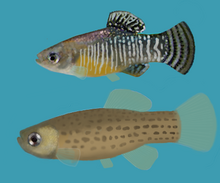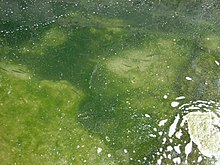Our website is made possible by displaying online advertisements to our visitors.
Please consider supporting us by disabling your ad blocker.
Spanish toothcarp
| Spanish toothcarp | |
|---|---|

| |
| Male toothcarp (top) and female toothcarp (bottom) | |
| Scientific classification | |
| Domain: | Eukaryota |
| Kingdom: | Animalia |
| Phylum: | Chordata |
| Class: | Actinopterygii |
| Order: | Cyprinodontiformes |
| Family: | Aphaniidae |
| Genus: | Apricaphanius |
| Species: | A. iberus
|
| Binomial name | |
| Apricaphanius iberus (Valenciennes, 1846)
| |

| |
| Distribution of Aphanius Iberus in Spain | |
| Synonyms[2] | |
| |

The Spanish toothcarp (Apricaphanius iberus), also known as the Spanish pupfish or Iberian killifish,[3][4] is a small, endemic species of fish in the family Aphaniidae. Its risk of extinction is one of the greatest of any Iberian vertebrate. Its limited range, coupled with the drastic population decline the species has suffered in the last two decades, has caused it to be placed on endangered species lists, both in Spain and internationally. In addition, habitat fragmentation, likely due to humans, has resulted in this species becoming increasingly stagnant and has led to increased genetic drift. Also found to be contributing to their endangerment was genetic diversity of mitochondrial DNA. The mitochondrial DNA coupled with A. iberus's geographic distribution has been able to affect their population genetic structure gradually in different spaces. Its conservation status in the south of the Iberian Peninsula has notably worsened.
A similar fish in the peninsula's south-west has been classified as an independent species, Apricaphanius baeticus. Apricaphanius saourensis is another similar species in Algeria.
- ^ Ford, M. (2024). "Apricaphanius iberus". IUCN Red List of Threatened Species. 2024: e.T1846A137218389. doi:10.2305/IUCN.UK.2024-2.RLTS.T1846A137218389.en. Retrieved 27 January 2025.
- ^ Bailly, Nicolas (2023). "Apricaphanius iberus (Valenciennes, 1846)". WoRMS. World Register of Marine Species.
- ^ Froese, Rainer; Pauly, Daniel (eds.). "Apricaphanius iberus". FishBase. April 2024 version.
- ^ "'Aphanius iberus'". Integrated Taxonomic Information System.
Previous Page Next Page



